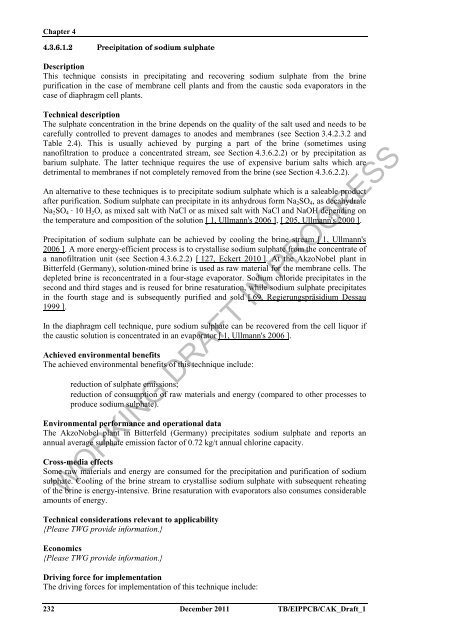(BAT) Reference Document for the Production of Chlor-alkali ...
(BAT) Reference Document for the Production of Chlor-alkali ...
(BAT) Reference Document for the Production of Chlor-alkali ...
Create successful ePaper yourself
Turn your PDF publications into a flip-book with our unique Google optimized e-Paper software.
Chapter 4<br />
4.3.6.1.2 Precipitation <strong>of</strong> sodium sulphate<br />
Description<br />
This technique consists in precipitating and recovering sodium sulphate from <strong>the</strong> brine<br />
purification in <strong>the</strong> case <strong>of</strong> membrane cell plants and from <strong>the</strong> caustic soda evaporators in <strong>the</strong><br />
case <strong>of</strong> diaphragm cell plants.<br />
Technical description<br />
The sulphate concentration in <strong>the</strong> brine depends on <strong>the</strong> quality <strong>of</strong> <strong>the</strong> salt used and needs to be<br />
carefully controlled to prevent damages to anodes and membranes (see Section 3.4.2.3.2 and<br />
Table 2.4). This is usually achieved by purging a part <strong>of</strong> <strong>the</strong> brine (sometimes using<br />
nan<strong>of</strong>iltration to produce a concentrated stream, see Section 4.3.6.2.2) or by precipitation as<br />
barium sulphate. The latter technique requires <strong>the</strong> use <strong>of</strong> expensive barium salts which are<br />
detrimental to membranes if not completely removed from <strong>the</strong> brine (see Section 4.3.6.2.2).<br />
An alternative to <strong>the</strong>se techniques is to precipitate sodium sulphate which is a saleable product<br />
after purification. Sodium sulphate can precipitate in its anhydrous <strong>for</strong>m Na2SO4, as decahydrate<br />
Na2SO4 · 10 H2O, as mixed salt with NaCl or as mixed salt with NaCl and NaOH depending on<br />
<strong>the</strong> temperature and composition <strong>of</strong> <strong>the</strong> solution [ 1, Ullmann's 2006 ], [ 205, Ullmann's 2000 ].<br />
Precipitation <strong>of</strong> sodium sulphate can be achieved by cooling <strong>the</strong> brine stream [ 1, Ullmann's<br />
2006 ]. A more energy-efficient process is to crystallise sodium sulphate from <strong>the</strong> concentrate <strong>of</strong><br />
a nan<strong>of</strong>iltration unit (see Section 4.3.6.2.2) [ 127, Eckert 2010 ]. At <strong>the</strong> AkzoNobel plant in<br />
Bitterfeld (Germany), solution-mined brine is used as raw material <strong>for</strong> <strong>the</strong> membrane cells. The<br />
depleted brine is reconcentrated in a four-stage evaporator. Sodium chloride precipitates in <strong>the</strong><br />
second and third stages and is reused <strong>for</strong> brine resaturation, while sodium sulphate precipitates<br />
in <strong>the</strong> fourth stage and is subsequently purified and sold [ 69, Regierungspräsidium Dessau<br />
1999 ].<br />
In <strong>the</strong> diaphragm cell technique, pure sodium sulphate can be recovered from <strong>the</strong> cell liquor if<br />
<strong>the</strong> caustic solution is concentrated in an evaporator [ 1, Ullmann's 2006 ].<br />
Achieved environmental benefits<br />
The achieved environmental benefits <strong>of</strong> this technique include:<br />
reduction <strong>of</strong> sulphate emissions;<br />
reduction <strong>of</strong> consumption <strong>of</strong> raw materials and energy (compared to o<strong>the</strong>r processes to<br />
produce sodium sulphate).<br />
Environmental per<strong>for</strong>mance and operational data<br />
The AkzoNobel plant in Bitterfeld (Germany) precipitates sodium sulphate and reports an<br />
annual average sulphate emission factor <strong>of</strong> 0.72 kg/t annual chlorine capacity.<br />
Cross-media effects<br />
Some raw materials and energy are consumed <strong>for</strong> <strong>the</strong> precipitation and purification <strong>of</strong> sodium<br />
sulphate. Cooling <strong>of</strong> <strong>the</strong> brine stream to crystallise sodium sulphate with subsequent reheating<br />
<strong>of</strong> <strong>the</strong> brine is energy-intensive. Brine resaturation with evaporators also consumes considerable<br />
amounts <strong>of</strong> energy.<br />
WORKING DRAFT IN PROGRESS<br />
Technical considerations relevant to applicability<br />
{Please TWG provide in<strong>for</strong>mation.}<br />
Economics<br />
{Please TWG provide in<strong>for</strong>mation.}<br />
Driving <strong>for</strong>ce <strong>for</strong> implementation<br />
The driving <strong>for</strong>ces <strong>for</strong> implementation <strong>of</strong> this technique include:<br />
232 December 2011 TB/EIPPCB/CAK_Draft_1







